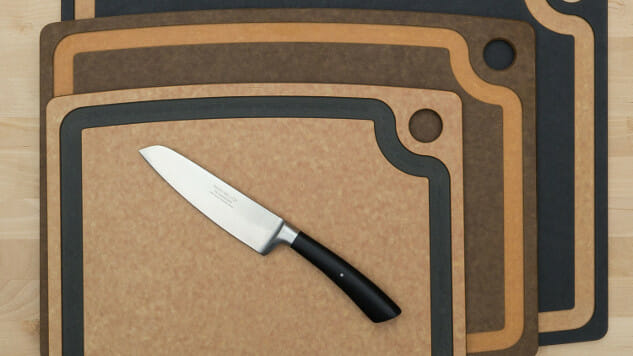Maybe you can’t take that ten-week French Cuisine Intensive course at the local cooking school, or a new marble countertop and deluxe Vitamix aren’t in your budget this year. Fortunately, the skills it takes to grow as a home cook are hard-won by putting in the hours and paying attention to detail, not by burning up your credit card. You’re already making dinner many nights anyway—why not approach it as a learning opportunity? Here are some small changes you can make that will have big payoffs in culinary success.
Keep a ruler in your gadget drawer
…and use it frequently. Though it doesn’t sound like much, the size or thickness of foods can really impact both their cooking times and final textures. Sometimes I don’t totally trust my instincts—what I estimate is a quarter-inch dice might be half an inch—so I occasionally double-check with my ruler if a recipe calls for foods to be cut in a specific size. This way, all of the vegetables in a stew have the same doneness. Also, if I’m unsure of the diameter of a pan, I make sure to measure it, since that can impact cooking and baking times, too.
Use a digital scale whenever possible
Scales are faster and much more accurate than using volume measurements. You can measure dry ingredients all into the same bowl, saving you dirty measuring cups to wash. It’s win-win. A good digital scale costs only $20 or so, and recipes increasingly call for ingredients in ounces or grams in addition to volume measurements.
Get your knives sharpened
That is, if they are worth sharpening. If they’re junky, go get a sharp new one. If your knives are decent, get your favorite one sharpened. A dull knife makes prep work a drag—literally. As I am reminded every time I cook at a relative’s house, cutting ingredients with a dull knife takes so much longer, and your food looks like it’s been prepped by a lawn mower.
Look in the phone book or online to see if there’s a good sharpening service in your area—or ask a friend whose knives are sharp where they go.
Use an oven thermometer
Most ovens don’t run accurately—they can be up to fifty degrees too hot or cold. Not only can it impact the flavor of foods you cook (cookies that brown too quickly, a gratin that curdles because the heat was too high), it can extend cooking times beyond what you’re expecting. Ever had a roast chicken take seemingly forever to get to an internal temp of 165 degrees F? Maybe your oven is slow. An oven thermometer will solve the mystery at a glance. I’ve noticed that the cheap ones from the grocery store do as good of a job as the more expensive models, so skimping on this one is fine.
Taste foods as they cook
Taste, taste and taste again. In a decent restaurant, the kitchen staff tastes everything—sometimes multiple times—before it gets sent out to the table. This goes for foods prepped in batches, such as soups, as well as foods cooked in individual portions to order, like pan sauces. Doing this at home will transform the dining experience for everyone at the table. Those last-minute adjustments of adding a little salt, lemon juice, or spice are what make flavors really pop. This is especially important if you’re trying a recipe for the first time, since even the most solid recipe is crafted to reflect the tastes of its creator, not you.
Get rid of equipment you hate
Cluttered countertops make prep work cramped and stressful, and cupboards jammed with bulky specialty pans and gadgets make finding the pans you actually need a headache. Pack up or give away seldom-used appliances to free up space for both yourself and the cooking tools you love.
Use your judgement with cooking times when following a recipe
Every cooking range and oven—even in a test kitchen—has its own quirks, which means the cooking times in recipes are there to give you a ballpark of then the food will attain its optimal doneness. I usually round down a few minutes and start checking early so my food does not accidentally overcook.
Trust yourself
Confidently identifying when food has reached its perfect doneness is a big stumbling block for many home cooks. A good recipe will give visual cues, not just cooking times, so keep an eye out for the color, firmness, and aroma of a food as it cooks. Touch its surface and take note of what it feels like at different stages so you can file that away in your memory bank for the next time you cook.
When in doubt, use an instant-read thermometer
Cheap little instant-read probe thermometers are your insurance if you’re unsure if that chicken breast really is cooked all the way through, or if that very expensive standing rib roast is medium-rare since you surely don’t want it well-done. I prefer dial thermometers to digital ones, since they can be easily calibrated and seem to last loner, but digital ones are easier to read.
Loosen Up
If you’re reading this, you probably like to cook, so set aside time to cook the things that make you happy. If those things happen to be full of empty calories (I’m lookin’ at you, cupcakes), share them with others. If you try cooking foods you’re unfamiliar with and the results don’t meet your expectations, don’t be hard on yourself. It takes years to master cooking, and even the world’s top chefs will admit that overcoming failures and learning new skills is what keeps them on their toes years and years into their careers.
Sara Bir is Paste’s food editor, a graduate of The Culinary Institute of America, and the author of The Pocket Pawpaw Cookbook. Follow her on Twitter: @Sausagetarian.
Photo by Didriks CC BY
